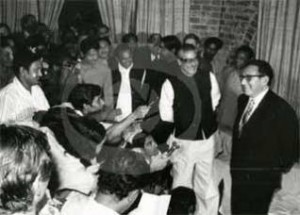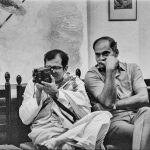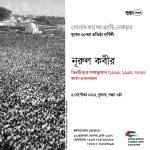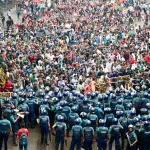by rahnuma ahmed
The incongruencies were many. They helped to sow suspicion among members of the public. The general relief felt in the early period of the caretaker government’s takeover, gradually slipped away.
Having failed to gain legitimacy, the consortium government finally relinquished power on January 6, 2009, after the December 2008 electoral results declared Awami League the winner, that too, with a landslide victory.
I was reminded of Pakistan’s president Parvez Musharraf because the US government (which headed the ‘western bloc,’ the third constitutive element of the consortium government) had learnt a lesson from Musharraf’s regime. The latter had suffered from a legitimacy crisis (some say, Musharraf had used it at times to stave off some of the demands made by the Bush administration); the lesson which the American administration had learnt was that a government voted to power, albeit, under conditions favorable to imperial policies and interests, is not similarly encumbered.
The consortium had expected that the programme of political reforms initiated by the Fakhruddin-Moeenuddin regime would require a length of time sufficiently prolonged to ensure that the leaders of the Awami League and the Bangladesh Nationalist Party ‘retired’ from active politics. Techniques to pressurise them to do so were coupled with measures which would induce fear, helplessness and a deep sense of insecurity: arrest, solitary confinement, corruption cases, enticing senior party leaders away with offers of leadership positions in the king’s party, thereby, weakening the party organisationally, leaving it rudderless. In the case of Khaleda Zia, remand and torture of her eldest son Tareque Zia, was an added psychological pressure.
In other words, the basic strategy to ‘minus’ the two leaders involved drawing up corruption cases against them, and confining and isolating them, undoubtedly frightening for Hasina and Khaleda, accustomed as they were to deep and comforting layers of sycophancy (these, notably, have been restored after their comeback).
Simultaneously, these were accompanied by efforts to form a king’s party. As a matter of fact, it is probably not incorrect to say that dismantling the two older political parties and creating conducive grounds for the formation of a new one — were opposite sides of the same coin. (There was a fallback plan as well, the formation of a national unity government, composed of a coalition of civil-military bureacrats, technocrats, business and political elites).
When I look back, it seems that the planners of the consortium government had almost arithmetically calculated that if a person with the requisite status and charisma were to be introduced on the political landscape, he would easily, almost automatically be able to fill the vacuum in political leadership which had been created through minus-ing the two leaders, enticing away senior party leaders, dismantling the main parties etc., etc. That he would almost automatically be able to win the people’s hearts and minds, badly bruised as they were from two decades of political instability (at times, crippling), from the politics of murder and mayhem. That he would be able to form a political party which would gain broad layers of support from the people, that this would lead to his being swept into office through the national elections. That the consortium would then be able to retire, after having deposited the rein of government in the hands of a person untainted by party politics. In their mind’s eye, the leader of the king’s party needed to be someone who could govern the nation rationally, and rationality for them, could be nothing else but submission. Of oneself, and one’s poor nation, humbly too, for being provided with the opportunity of surrendering our collective will to that of the most powerful nation on earth.
From the consortium government’s point of view, Dr. Muhammad Yunus’ winning of the Nobel Prize, accompanied by his desire to enter politics, could not have occurred at a more opportune moment. But I will come to that later, a quick look at Bangladesh and America’s shared history, and several other issues first.

The US administration has a history of directly intervening in Bangladesh’s politics, the disastrous consequences of which have been borne by the overwhelming majority. No, I’m not referring to the Nixon administration’s support for the Yahya government as it conducted a genocidal campaign against us, who were East Pakistanis then, in 1971. Nor am I speaking of the arrival of the US Seventh Fleet in the waters of the Bay of Bengal in December 1971, as it became undeniably clear that Pakistan, its stalwart ally, was losing the country’s eastern wing. And no, neither am I hinting at the 1974 famine, when the US government decided to withhold 2.2 million tons of food grains to pressurise the Mujib regime to abandon its plans to “try Pakistani war criminals.” Henry Kissinger, then US secretary of state, had advised the Bangladesh finance minister to quickly settle its disputes with Pakistan. “Humanity,” said Kissinger, had never learnt from war crimes trials.
What I wish to refer to instead, is the brutal assassination of Sheikh Mujibur Rahman, the founding president of the nation, in August 1975. Kissinger had come to South Asia in 1974, reportedly, on a “face-saving” tour. He stopped in Dhaka for a mere eight hours, he addressed a press conference for all of three minutes. When asked why he’d sent the US fleet to the Bay of Bengal, he declined to answer. End of press conference.
A week after Kissinger’s return to Washington, a couple of US embassy officials in Dhaka secretly met with a group of disaffected army officers, who were keen to oust Mujib from power. The coup occurred on August 15, 1975. Sheikh Mujib and forty others, including all family members (excluding his 2 married-out daughters, Hasina and Rehana), relatives, government officials and household staff — were killed in cold blood. Lawrence Lifschultz’s exhaustive research demonstrates how the US “two track” policy had been set in motion in Bangladesh, as in Latin American countries. Intelligence officials stationed in the embassy would contact Washington directly, over the heads of the ambassador. Without the latter’s knowledge.
Those critical of the Fakhruddin-Moeenuddin regime for its undemocratic and unconstitutional character — the usurpation of power contrary to that which is decreed by the constitution, the suspension of fundamental rights, the general reign of terror unleashed by the security forces, its absolute disregard and contempt for poor people’s livelihoods and homes as army personnel tore down huts, shanties and roadside shops (because they were “illegal”), cleared the pavements of hawkers and sellers, proved incapable of controlling the rising prices of food and other consumables — have heightened our awareness of the role played by western diplomats stationed in Dhaka, of their “frenzied activity” prior to the consortium coup, and, subsequently.
Readers might remember the lines with which I’d concluded Part I: “While the participation and involvement of the military leadership and shusheel shomaj was essential for achieving the central objective of the consortium government — remapping the political field — the steering capacity of the consortium project, and the consortium government, rested in the hands of western diplomats/governments.”
Do I have any evidence that western governments were involved, that they were, as I’ve argued, a constitutive element in the consortium government? It is only reasonable to raise this question. But how can one know?
If one has to wait for official US documents, it promises to be a long wait since all classified documents in the US are declassified — except those which are opposed by the concerned agency or department because it may endanger the life and/or career of a source, harm state-to-state relations, or imperil an ongoing clandestine operation — after twentyfive years, which in this case means 2032!
But even if we could afford to fold our hands and wait that long, there are other problems as well. With the noticeable transformation of the US into a police state (if one were to set aside the ‘mere’ matter of 10 million natives exterminated after Columbus’ discovery of the New World, some authors put the figure much higher) after 9/11, there is good ground to believe that those documents which could have seen the light of day, simply won’t. Not even 25 years later.
Published in New Age, Wednesday, February 29, 2012
Part VII
Part VI
Part V
Part IV
Part II
Part I





Leave a Reply
You must be logged in to post a comment.